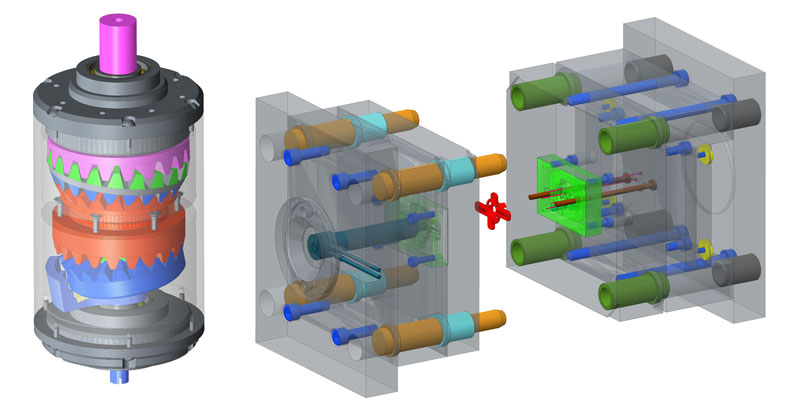by Giulia Barbagelata (STAM), Marco Attene (CNR-IMATI) and Tor Dokken (SINTEF)
CAxMan will establish novel workflows and services for discrete manufacturing (combinations of additive and subtractive), by showcasing the CAx-technologies as cloud-based services and workflows, from design to production of physical prototypes.
High-tech software for engineers is expensive – often too expensive for small and medium-sized enterprises (SMEs) to use regularly. In the EU project CAxMan (Computer Aided Technologies for Additive Manufacturing) researchers are developing special cloud enabled design and simulation solutions addressing additive manufacturing (AM) and targeting the needs of SMEs. AM is a technology that builds 3D objects by adding layer-upon-layer of material, contrary to subtractive manufacturing by which 3D objects are constructed by cutting excess away from a solid block of material.
An engineer’s most important tool is a computer: be it a bridge, a car or a lawn mower, every product these days is designed on a computer. Its suitability for purpose is often tested through computer simulations well prior to the first prototype; at least in theory. This is actually the case for subtractive manufacturing. For AM, dedicated tools for computer aided technologies (CAx) are fragmented, and in many important aspects rudimentary or completely lacking.
It is the mission of the thirteen CAxMan partner institutions (covering seven EU countries and including research, IT-industry, service providers and manufacturing industries) to form an innovative and world class team to improve this situation.
The idea is to develop new design and simulation technologies addressing the specificities of additive manufacturing and to make them available as cloud services, exploiting the infrastructure of the FP7 project CloudFlow [L1].
The cloud infrastructure will make it easy for both small and large enterprises to access these new technologies. Expensive specialised software will no longer be installed on the engineer’s computers, but will run via internet on the cloud. On this open platform, products may be designed and simulated. The available servers provide high performance computing (HPC) solutions, capable of solving very complex problems.
The project will establish novel workflows and services for additive and subtractive manufacturing by addressing analysis/simulation-based design, analysis/simulation of process planning, and showcasing the CAx technologies for two use cases:
- Use Case 1: NUGEAR is an example of a product that is too expensive to produce by subtractive manufacturing alone, where additive manufacturing is used to create tailored workpieces to reduce the use of subtractive manufacturing to attain the required surface quality. The NUGEAR (NUtating GEARbox) is an innovative gearbox that couples the mathematical concept of nutation with bevel gears [1]. The main bottleneck of NUGEAR’s manufacturing is the production of internal bevel gears (bevel gears whose pitch cone angle is larger than 90°), which are needed in the nutating gearbox.
- Use Case 2: Injection moulds as an example of a product that incorporates functional cavities into a single component, where production by subtractive manufacturing would require multiple components. One of the biggest and most complex constraints is the thermal regulation of the mould: poor thermal regulation can result in a bad plastic part with a lot of defects. Therefore, cavities are used as cooling channels, which must be properly designed and pose serious constraints due to the subtractive manufacturing.
In principle the layer-by-layer approach of additive manufacturing makes it possible to build components of any level of complexity. However, in practice, the situation is more complicated: support structures have to be added to avoid errors in material deposition, the part has to be oriented in order to obtain suitable surface finish, physical limitations and constraints have to be taken into consideration as well as the actual behaviour of the material during the process, etc. As most 3D printing today is based on STL-files, interoperability with design is currently poor.
In CAxMan a feedback loop will be established between design and process planning for additive manufacturing. The process planning starts by analysing the design and, after having specified the process to be used, a process plan is generated. This will provide requests for revision to the design phase before passing the process plan on to manufacturing and ensuring that the final manufactured object is as close to the design as possible. Such interoperability will significantly shorten the lead time and will enable the development of much more flexible and effective design environments for additive manufacturing applications.

Figure 1: The two use case demonstrators that will be used to assess CAxMan developments: the NUGEAR (left) and an Injection Mould (right).
The objectives of CAxMan are to establish cloud based toolboxes, workflows and a one stop-shop for CAx-technologies supporting the design, simulation and process planning for additive manufacturing. The analysis-based design approaches will make it possible:
- To reduce material usage through internal cavities and voids, maintaining component properties;
- To optimise distribution and grading for multi-material processes;
- To facilitate the manufacture of components which are currently very difficult to produce by subtractive processes;
- To enhance analysis-based process planning for additive manufacturing including thermal and stress aspects, and their interoperability with the design phase;
- To enable the compatibility of additive and subtractive processes in production.
Unlike current CAD/CAE/CAM tools, CAxMan will guarantee unpreceded interoperability among product development steps, will focus on cost effectiveness and will be developed expressly for AM.
In conclusion, the CAxMan set of CAD/CAE/CAM tools will speed up and improve the design/engineering/manufacture process and optimise the AM process, for the benefit of designers, engineers and manufacturers of mechanical products who want to get the best out of AM and reduce production costs.
CAxMan has received funding from the European Union’s Horizon 2020 research and innovation programme under grant agreement No 68044.
Link:
[L1] http://www.eu-cloudflow.eu
Reference:
[1] P. Fanghella, L. Bruzzone, S. Ellero and R. Landò: “Kinematics, Efficiency and Dynamic Balancing of a Planetary Gear Train based on Nutating Bevel Gears”, Mechanics Based Design of Structures and Machines: an International Journal, vol. 44, Issue 1-2, 2016.
Please contact:
Giulia Barbagelata, Stam S.r.l., Italy
Marco Attene, CNR-IMATI, Italy
Tor Dokken, SINTEF, Norway











